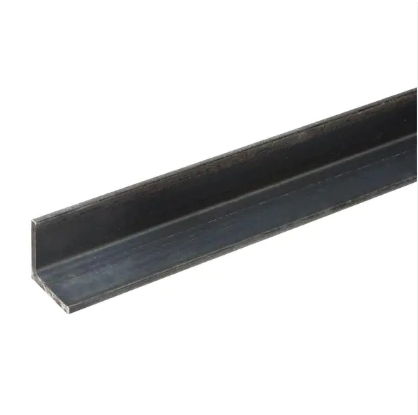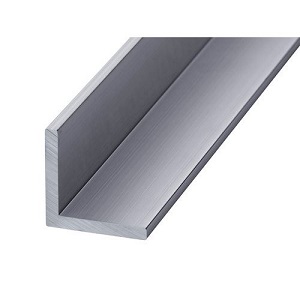Choosing steel angle or aluminum angle is a topic worthy of discussion in project construction. Each material has unique properties and can meet different needs. In this article, This comprehensive guide will explore the properties, applications, and considerations of steel and aluminum angles to help you make an informed decision for your next project.
①Lightweight
The density of aluminum is about one-third that of steel. This is undoubtedly a big advantage in the design of building structures that account for a relatively large proportion of their own weight. Therefore, aluminum alloy structures usually give people a light appearance.
②Low elastic modulus
The elastic modulus of aluminum alloy is only one-third that of steel, so aluminum alloy is easier to buckle than steel structure, and the stability coefficient in the specification is also much lower than that of steel structure (think of our common cans). Therefore, deformation and stability are more common problems in aluminum alloys, and the advantages of its light material are offset by large deformations.
③Extrusion molding
Aluminum alloy materials are very soft, so unlike rolling and welding, which are commonly used in the production of traditional steel structures, aluminum alloys are usually extruded. The unique extrusion process can produce components with various complex cross-sections, and the various connectors we need can be integrated with the main structure through extrusion. At the same time, aluminum alloy components and nodes can be prefabricated in batches and then assembled. This production model is very suitable for the factory-based assembly structure we currently advocate. It has great advantages for large-scale aluminum alloy space structures with a large number of repetitive characteristic bars and nodes. Good applicability.
Aluminum angles are favored in:
Angle steel is easy to install and maintain, and it has strong welding performance, but in harsh environments, it requires frequent inspection and maintenance to prevent rust.
Aluminum angles are easier to work with due to their lightweight and flexibility. They also require less frequent maintenance, given their inherent corrosion resistance. When designing steel structure welding, the weld can be as strong as the component, while aluminum alloy welding will significantly reduce the material cost. Strength and ductility, so mechanical connections are often used in the connection of aluminum alloys.
Due to their weight and tendency to rust, steel angles are rarely used in decorative structures, while aluminum angles are lightweight, corrosion-resistant and easy to clean, making them suitable for long-term decorative use.
When selecting between steel and aluminum angles, consider the long-term implications of your choice. Both materials have their merits, and the optimal selection will ensure the success and longevity of your project.
1.What is angle steel?
Angle steel, also known as angle iron, is a material widely used in the construction field. The following is the basic information about this metal structure.| Category | Description |
|---|---|
| Product Name | Angle Steel |
| Classification | Equal and Unequal Angle Steel |
| Material | Carbon Structural Steel, Stainless Steel |
| Shape | A long steel bar with two sides perpendicular to each other forming an angular shape |
| Features | High strength, durable, available in various sizes and finishes, versatile for multiple applications |
| Applications | Used in construction, industrial framing, machinery support, and more |
2.Material Properties and Comparison
(1) Fundamental Properties of Steel Angles
Strength and durability: Since angle steel is made of carbon steel or stainless steel through hot rolling, this metal material has high strength and durability, and is suitable for applications that require high strength, such as beams, bridges, transmission towers, and cranes. Heavy transport machinery and ships.
(2)Fundamental Properties of Aluminum Angles
①LightweightThe density of aluminum is about one-third that of steel. This is undoubtedly a big advantage in the design of building structures that account for a relatively large proportion of their own weight. Therefore, aluminum alloy structures usually give people a light appearance.
②Low elastic modulus
The elastic modulus of aluminum alloy is only one-third that of steel, so aluminum alloy is easier to buckle than steel structure, and the stability coefficient in the specification is also much lower than that of steel structure (think of our common cans). Therefore, deformation and stability are more common problems in aluminum alloys, and the advantages of its light material are offset by large deformations.
③Extrusion molding
Aluminum alloy materials are very soft, so unlike rolling and welding, which are commonly used in the production of traditional steel structures, aluminum alloys are usually extruded. The unique extrusion process can produce components with various complex cross-sections, and the various connectors we need can be integrated with the main structure through extrusion. At the same time, aluminum alloy components and nodes can be prefabricated in batches and then assembled. This production model is very suitable for the factory-based assembly structure we currently advocate. It has great advantages for large-scale aluminum alloy space structures with a large number of repetitive characteristic bars and nodes. Good applicability.

3.Application Scenarios and Project Requirements
(1) Application Areas of Steel Angles
Steel angles are widely used in:- Construction frameworks and structural beams
- Automobile bodies and chassis
- Railway tracks and train components
(2)Application Areas of Aluminum Angles
Aluminum angles are favored in:
- Aircraft and aerospace components for their lightweight properties
- Lightweight vehicle parts to improve fuel efficiency
- Marine structures due to their corrosion resistance in saltwater environments.
4.Cost and Sustainability
(1)Cost Analysis
Generally speaking, due to the easy availability of raw materials, the initial price of steel angles will be cheaper than Aluminum Angles, but the price is affected by many factors, such as quantity and degree.(2)Sustainability Considerations
Compared with steel, aluminum angle is easy to recycle, has low reprocessing cost, high reuse rate and high recycling value. It is an energy-saving, environmentally friendly and green material. The leftover materials from actual production can be recycled at a relatively high price, reducing the loss cost of the aluminum alloy structure.
5.Installation, Maintenance, and Operational Advice
Angle steel is easy to install and maintain, and it has strong welding performance, but in harsh environments, it requires frequent inspection and maintenance to prevent rust.Aluminum angles are easier to work with due to their lightweight and flexibility. They also require less frequent maintenance, given their inherent corrosion resistance. When designing steel structure welding, the weld can be as strong as the component, while aluminum alloy welding will significantly reduce the material cost. Strength and ductility, so mechanical connections are often used in the connection of aluminum alloys.
6. Decorative Uses and Aesthetic Considerations
Due to their weight and tendency to rust, steel angles are rarely used in decorative structures, while aluminum angles are lightweight, corrosion-resistant and easy to clean, making them suitable for long-term decorative use.
7. Conclusion and Selection Recommendations
When selecting between steel and aluminum angles, consider the long-term implications of your choice. Both materials have their merits, and the optimal selection will ensure the success and longevity of your project.| Section | Steel Angles | Aluminum Angles |
|---|---|---|
| Properties | High strength, durable, heat-resistant | Lightweight, corrosion-resistant, flexible |
| Application Areas | Construction, automotive, railways | Aerospace, marine, electrical transmission |
| Project Requirements | Best for heavy-duty, large structures | Ideal for lightweight, flexible applications |
| Cost Analysis | Generally less expensive initially | Higher initial cost, but potentially cost-effective long-term |
| Sustainability | Less energy-efficient in production | More energy-efficient, highly recyclable |
| Installation & Maintenance | Straightforward, but requires rust prevention | Easy to work with, less maintenance |
| Decorative Uses | Limited due to weight and rust potential | Preferred for decorative purposes |
| Conclusion | Opt for steel if strength and durability are key | Choose aluminum for lightweight and corrosion resistance |









